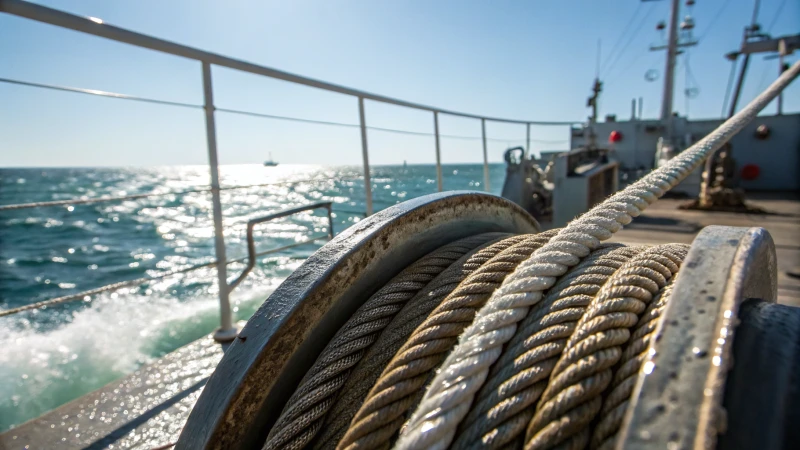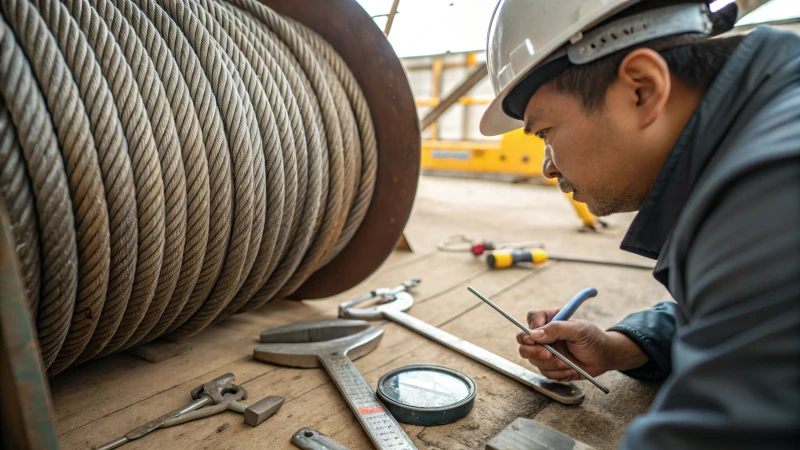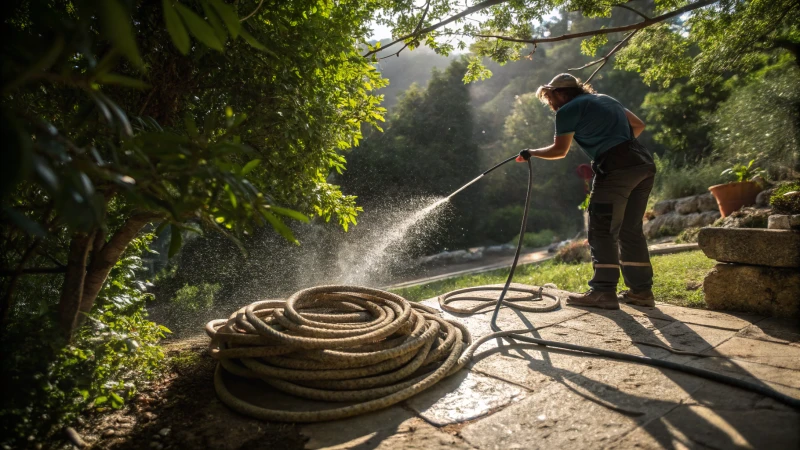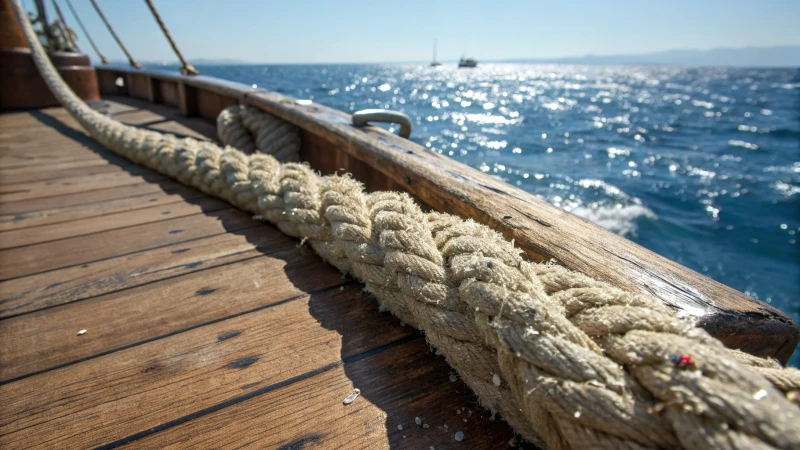
I've spent countless hours by the sea, watching steel wire ropes battle the relentless marine environment.
To maintain corrosion-resistant steel wire rope in marine environments, I recommend regular inspections, rinsing with freshwater after salt exposure, applying marine-grade lubricants, and ensuring proper storage. These measures not only prevent corrosion but also extend the rope's lifespan significantly.
In my experience, these are just the basics. Regular inspections have saved me from unexpected failures more times than I can count. I've learned the hard way that a little time spent cleaning and inspecting can save a lot of time—and money—later on. Diving deeper, advanced techniques like magnetic particle inspection or applying the latest protective coatings can make all the difference. This comprehensive approach ensures not just safety but also the smooth operation of my projects.
Regular inspections prevent rope corrosion.True
Regular inspections help identify early signs of corrosion, enabling timely intervention.
Freshwater cleaning after salt exposure is unnecessary.False
Cleaning with freshwater removes salt residues, preventing corrosion.
How Can You Ensure Your Steel Wire Ropes Are Safe?
Have you ever wondered how to keep those sturdy steel wire ropes safe and sound in your operations?
The best inspection techniques for steel wire ropes involve regular visual inspections, advanced non-destructive testing (NDT) methods like ultrasonic and magnetic particle inspection, and routine tension testing to ensure they maintain their load-bearing capacity.

Visual Inspection: The First Line of Defense
I remember the first time I learned about the importance of visual inspections; it was during my early days in the industry. A seasoned mentor once told me that inspecting steel wire ropes is much like checking a car's tires before a long trip—essential for safety. During these inspections, I always look for signs like corrosion, frayed wires, or rust spots. I pay extra attention to high-stress areas such as lifting points, as these are prone to wear.
| Inspection Aspect | Details |
|---|---|
| Corrosion | Look for rust spots and discoloration |
| Fraying | Check for broken or frayed wires |
| Stress Points | Focus on lifting and contact points |
Non-Destructive Testing (NDT) Techniques
When I first heard about NDT, I was amazed by how it could reveal the hidden secrets inside a wire rope without causing any damage. Techniques like magnetic particle inspection1 and ultrasonic testing2 are like having X-ray vision—they detect micro-cracks and internal damage that aren't visible to the naked eye. These methods have become indispensable, especially for ropes used in critical applications.
Tension and Load Testing
One lesson I've learned is that regular tension testing is non-negotiable. Imagine trying to lift a heavy load with a rubber band—proper tension ensures that the ropes perform within their load capacity, especially after harsh conditions like a storm.
Environmental Factors and Maintenance
My experience has taught me the importance of cleaning ropes exposed to saltwater. Freshwater rinsing helps remove salt residues that can accelerate corrosion. Using non-corrosive cleaning agents maintains their protective coatings.
- Lubrication: Applying marine-grade lubricants3 protects against moisture ingress and reduces friction.
Importance of Regular Inspections
Routine inspections are like regular health check-ups for your ropes. They allow me to detect issues early, preventing catastrophic failures. This is especially crucial in environments with high humidity or chemical exposure, where ropes are more prone to degradation.
Understanding these techniques not only improves safety but also boosts efficiency in operations involving steel wire ropes. Whether you're in procurement or maintenance, this knowledge is indispensable.
Visual inspections can detect internal wire rope damage.False
Visual inspections are effective for surface issues, not internal damage.
Marine-grade lubricants prevent moisture ingress in ropes.True
They form a protective barrier against moisture, reducing corrosion.
How Can Cleaning and Rinsing Extend Rope Lifespan?
Have you ever wondered how a little extra care can make your ropes last longer? Let's dive into the simple ways cleaning and rinsing can breathe new life into your trusty ropes.
By regularly cleaning and rinsing ropes, you can effectively remove damaging residues like salt, dirt, and chemicals. This simple maintenance routine helps preserve the rope's fibers and coatings, significantly extending its lifespan.

The Role of Salt and Dirt in Rope Degradation
I remember the first time I realized the impact of the environment on my ropes. It was during a particularly salty sea adventure, where every strand seemed to carry a crust of salt. Over time, I learned that salt and dirt are relentless foes, infiltrating and weakening even the toughest fibers. Salt, with its sneaky crystallizing nature, creates tiny abrasions that you might not notice until it's too late. Dirt, on the other hand, likes to hide deep within the fibers, adding unnecessary friction every time you use your rope.
Effective Cleaning Techniques
Cleaning ropes became a ritual for me—one that I actually began to enjoy. Picture this: a sunny afternoon, fresh water flowing through the fibers, washing away the remnants of the week's adventures. It's quite therapeutic! A gentle soap does wonders on stubborn spots, and rinsing twice ensures no residue remains. I always hang my ropes in the shade, allowing them to dry slowly while I sip a cold drink and admire my handiwork.
Here's a simple cleaning routine:
| Step | Description |
|---|---|
| Rinse | Use cold, fresh water to rinse off surface debris. |
| Wash | Apply a mild soap solution to scrub the rope gently. |
| Rinse Again | Thoroughly rinse to remove all soap residues. |
| Dry | Hang the rope in a shaded, well-ventilated area. |
This process ensures that no harmful residues remain on the rope, preserving its longevity.
Selecting the Right Cleaning Products
Choosing the right cleaning products felt like selecting a good book—once you find the right one, it makes all the difference. I opt for pH-neutral soaps that don't leave any residue. It's crucial to avoid anything too harsh that might strip away protective coatings or damage those precious fibers.
Understanding the chemistry4 behind these products is essential for effective maintenance.
Maintenance Schedule and Inspection
Over time, I developed a routine based on my adventures:
- Marine Environments: After every salty splash at sea to combat salt buildup.
- Construction Sites: Weekly affair to keep them in tip-top shape by removing dirt and dust.
- General Use: A monthly cleanup does the trick or after exposure to contaminants.
While cleaning, I take a moment to inspect them—looking for frays or discoloration that could indicate wear and tear. Early detection of issues can prevent failures during use.
Impact of Proper Drying
Drying ropes correctly became one of my non-negotiables after seeing UV damage firsthand. Ropes should be air-dried out of direct sunlight to prevent UV damage which can deteriorate fibers over time. Ensure they are hung loosely to allow airflow.
Maintaining ropes with these practices has not only extended their lifespan but also given me peace of mind. This proactive approach ensures safety and optimal performance in all my endeavors.
Salt accelerates rope corrosion by crystallizing.True
Salt crystals form micro-abrasions in ropes, weakening them.
Direct sunlight is ideal for drying ropes.False
Direct sunlight can cause UV damage, degrading rope fibers.
Why Is Lubrication Crucial for Marine Ropes?
Ever wondered why your marine ropes wear out so quickly despite careful handling?
Lubrication is vital for marine ropes because it reduces friction, prevents corrosion, and ensures smooth operation. Using marine-grade lubricants creates a protective barrier against saltwater, minimizing wear and extending the rope's service life.

Understanding Friction and Wear
From personal experience, I know that marine ropes endure some of the harshest conditions imaginable—saltwater and constant friction are their daily companions. I've seen how a well-lubricated rope can make all the difference, preventing those fibers from fraying prematurely. When I first started working with marine equipment, I learned the hard way that neglecting lubrication can lead to costly replacements and dangerous failures.
Types of Lubricants
- Marine-Grade Lubricants: Specifically designed to resist water ingress and prevent salt accumulation. I remember being introduced to these by a seasoned mariner who swore by their long-lasting protection.
- Biodegradable Options: These are perfect for those of us who care about the environment as much as our equipment. Offering protection without harming marine ecosystems is a win-win in my book.
| Type | Benefits |
|---|---|
| Marine-Grade | Long-lasting protection, moisture barrier |
| Biodegradable | Eco-friendly, no harm to marine life |
Corrosion Prevention
In my early days at sea, I learned that saltwater is a relentless adversary. Specialized lubricants form a protective barrier that prevents moisture penetration, effectively extending the rope's durability. It's like giving your ropes a shield against the elements.
Frequency of Application
You might think, "How often should I do this?" Regular lubrication is crucial, especially after cleaning or exposure to tough conditions. A colleague once told me about losing valuable equipment because they neglected this simple task. Trust me, reapplying lubricant to high-stress areas makes a significant difference in wear and tear.
Recommended Schedule:
- After Cleaning: Restoring protective barriers lost during cleaning is essential.
- Post-Operation: Following intense use to maintain lubrication levels—think of it as a post-workout stretch for your ropes.
Environmental Considerations
I always weigh performance against environmental impact when selecting lubricants. With biodegradable options now more available, it's easier than ever to keep our seas clean while maintaining our gear. For those interested in diving deeper into proper care and product selection, exploring marine-grade options5 is a good starting point.
Lubrication reduces marine rope friction and wear.True
Lubrication minimizes friction, preserving the rope's structural integrity.
Biodegradable lubricants harm marine ecosystems.False
Biodegradable lubricants are eco-friendly and safe for marine life.
How Can I Prevent My Ropes From Failing Prematurely Through Proper Storage?
Ever wondered why some ropes seem to last forever while others snap too soon? It all boils down to how you store them. Let's delve into the secrets of proper rope storage to keep them strong and reliable.
To prevent premature rope failure, I make sure to store ropes in a cool, dry spot, away from sunlight, chemicals, and moisture. Clean, dry spools are a must, and I ensure there's good ventilation to stave off mold and mildew.

Understanding the Impact of Storage Conditions
From my personal experience, I’ve seen how the environment can make or break the lifespan of ropes. Back when I first started handling ropes, I learned the hard way that temperature swings can weaken fibers by causing them to expand and contract. Nowadays, I opt for storage areas where I can control temperature and humidity. Investing in humidity control solutions6 has been a game-changer for me.
Protective Storage Techniques
Elevated Storage
Keeping ropes off the ground is something I swear by. I once had a batch stored directly on the floor, and moisture damage set in fast. Now, I use pallets or specialized shelves to keep them elevated. A storage rack system7 is worth considering if you have the space.
| Storage Type | Advantages | Considerations |
|---|---|---|
| Racks | Elevates ropes, prevents dirt | Needs space management |
| Pallets | Easy to move | Requires forklift access |
Use of Spools
I’ve also found spooling crucial for maintaining rope shape. Using non-corrosive materials for spools is key, and regular cleaning helps avoid debris buildup that could damage the ropes.
Avoidance of Harmful Substances
Another lesson from my early days was about keeping ropes away from harmful chemicals and oils. I can’t stress enough how important it is to establish a no-chemical zone in your storage area.
Ventilation and Light Exposure
Ventilation is another aspect not to overlook. I use fans in closed spaces to prevent mold and mildew. Direct sunlight is a no-go as UV rays can weaken synthetic fibers.
Regular Inspection and Maintenance
Finally, routine checks are part of my protocol. It’s like catching up with an old friend—you just make sure everything is as it should be. Inspections help spot wear and mold before they become big issues. I've started using a digital inspection system8 for keeping efficient records, which has been incredibly helpful.
Ropes stored in direct sunlight last longer.False
UV rays weaken synthetic fibers, reducing rope lifespan.
Humidity control prevents rope fiber weakening.True
Controlled humidity prevents expansion and contraction of fibers.
Conclusion
To maintain corrosion-resistant steel wire ropes in marine environments, conduct regular inspections, clean with freshwater, apply marine-grade lubricants, and store properly to extend lifespan and ensure safety.
-
Magnetic particle inspection helps identify surface and near-surface flaws, ensuring rope integrity. ↩
-
Ultrasonic testing detects internal defects, crucial for maintaining rope safety. ↩
-
Marine-grade lubricants provide essential protection against moisture and friction. ↩
-
Discover top-rated cleaning products designed for maintaining climbing ropes safely. ↩
-
Explore top-rated marine-grade lubricants that can enhance the durability and performance of your ropes. ↩
-
Explore options that help maintain optimal humidity levels, preventing damage from moisture. ↩
-
Learn about storage systems that help keep ropes elevated and organized. ↩
-
Discover digital tools that simplify regular inspections and record-keeping for stored ropes. ↩

